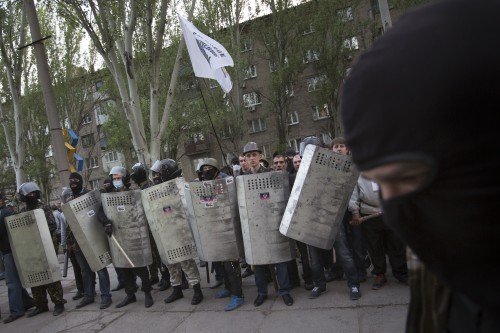The Ukrainian Conflict: A Ukrainian Nationalist View, Part 5: The Conflict in Eastern Ukraine

Masked pro-Russian demonstrators prepare to storm the military Prosecutor’s Office in Donetsk, eastern Ukraine, Sunday, May 4, 2014.
Returning to the events in a few (out of over a dozen) regions of eastern Ukraine, then there is a saying amongst many Ukrainians that, regarding Ukraine, the Kremlin is a slave to its own propaganda. It essentially creates its own myths and acts those myths out in real life as if they were somehow close to reality. One of the biggest myths the Kremlin created is that speaking Russian in Ukraine means having more loyalty to the Russian Federation than Ukraine.
This is why the Russian mercenaries have received so little support from the local population in eastern Ukraine. Even the commander of the Russian-funded mercenaries in eastern Ukraine (himself a citizen of the Russian Federation) stated quite clearly during a speech posted to You Tube that essentially, no locals are joining his ranks to “fight Ukrainian nationalists” (why not Ukrainian liberals?) — despite being provided with money and modern weapons. In fact, he stated that “those who join our ranks usually just get weapons, take some money and go home to rob shops. We provide people the opportunity to fight Ukrainian nationalists, but they would rather stay at home and drink beer.”
Eastern Ukraine in general is the more liberal region of Ukraine, and the Donbas region — the only eastern region of Ukraine where Russian-funded mercenaries have not yet been driven out — is by far the most liberal region of the country. Before these events, the leader of Donbas, who is now supporting the Russian mercenaries, even stated that “a gay parade would take place peacefully in our region.” (Incidentally, I hate constantly using homosexuals as an example, but the organized modern homosexual movement is simply a symbol of the dominance of liberal elites in Western societies that are hostile to the traditional peoples, cultures and ethnic identities of all European peoples.) In fact, as usual,only nationalists (and also members of Churches) went to protest the possibility of a parade in Donetsk. None of the current “anti-Western” movements were seen, nor were activists of the “Donetsk Peoples Republic.” . . .



